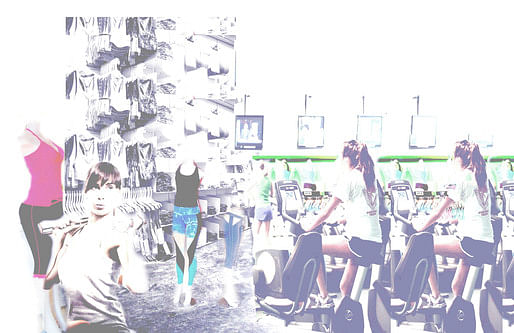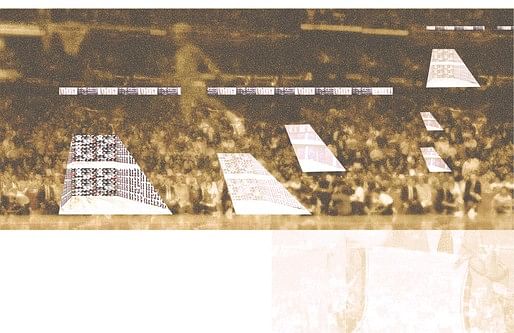
Shopping can literally happen anywhere. While SkyMall may have been a bit too much too soon, it is not uncommon now for people to spend time shopping between the opening and headlining acts at a concert. Retail stores cannot continue with business as usual, only focusing on a maximum capacity of items per square foot.
Much has been said of the decline of retail stores because of online shopping. Yet instead of seeing digital commerce as the death knell, we should view it as the retail store's liberator. Freed from the need of all sales to go through their physical stores, another layering of program can take place. So called "brick and mortar" stores are now places for events.
An athletic store not only has small simulated playing fields and courts, but the program is expanded to host games and tournaments. It is not only a place for athletic gear; it is a gym; it is a stadium. Most importantly, it is a community built around a common interest. And this community can share in an activity, trade tips and advice, and see their potential purchase live and direct.


Brands implying coastal leisure could give away sailing lessons in a raffle to customers. Perhaps wine and paint? Maybe poetry reading sessions? 
Already some stores display Instagram posts built around a theme. But can this be pushed more? Could we see have a photo contest and display winning entries on both the exterior and interior? Could this be a continuously changing gallery? A video contest to be projected on mannequins in-store? In this way, people are not only taking from a brand, they are interacting and contributing to it. The more shared ownership a person feels, the more personally connected they are.
And for more conservative and traditional brands, could we see political and policy debates being conducted? Invites to estate sales? What else might brands do to make their physical stores into places to be, meet, and go out together?
A layered retail program is not far off. If a brand already has a healthy in-store, online, email/communication network set up (omnichannel), the next step is to relax the push for in-store purchases and to grow in-store dwelling. Ultimately people want to feel a sense of belonging. Creating that place and fulfilling that need is mutually beneficial to both the brand and the customer.
Already, with a few stores, we see this new paradigm. Not only do they include photo booths, but they also hosts free concerts with complimentary PBR. Each new layer shows an understanding of both the advantages of a physical location and the lifestyle suggested by the brand.
The future success of brands will still be measured by sales, but it will prosper by the memories created.
~~~
In response to Nam's comment reprinted here:
To wit, see the NYT re: the move towards storefronts as "community outpost" and lifestyle centers. A place not just for shopping, but community meetings, shows or "just hanging out."
Definitely!! I totally agree that in contemporary society stores are taking on the role of community outpost. Leisure activities like web-surfing while drinking coffee should feel at this point to be a natural combination. I would love to check out the Tom's store and the store in Berlin.
This essay imagines maybe more programmatic overlays within a store that have a connection between the brand lifestyle and and the items being sold. But yes, leisure and lounging are definitely a strong first wave in the equation.
I also wonder if this kind of layering, instead of being more suited for dense cities, would be a welcomed new experience in smaller, more car based cities and suburbs. With the larger amount of space available for less cost, these suburban sites become testing grounds for what I'm seeing as a simulated urban condition.
I will chronicle my design research and degree project, providing commentary on my thought process at the time. From there, I will transform the body of work into a book which seeks to place into dialogue the two (currently) separated semesters of work.
2 Comments
I get the idea of more programmatic overlays, but also wonder if (along the lines of 'open office' / flexible spaces trend) the argument could be made you can actually increase the mix of uses with a less "programmed" space. Both architecturally or otherwise...?
I agree with you. I feel like architects and architecture appreciators, like things to unfold more naturally and allow the space to speak. Open office I see as something which increases friction and chance happenings which allow for further discussions and hopefully innovations. Plus for me, I like the open office because I feel like I am able to hear, see and learn more about the whys and hows of my office and how it works.
I see a potential for less programmed space, and it would actually be my personal end goal. Yet, I wonder: if there is no previous history of events taking place, no shared experiences between people, and no suggestions for how space could be used, I feel like people might be more inclined not to engage with each other and the spatial iterations might be very general and bland in the execution.
So for us, we already have in our minds a whole world of historical public spaces and cities that work wondrously while being less programmed. Perhaps though, for the strangers and the transplants, a shared program/experience is needed to get a conversation going.
Hmm, basically, I think the miesian box is good if I already have in mind what I want to do there, but maybe it has a hard time working if I am going there with no pre-planned intentions.
I am also wondering if retailers could experiment with taking the "style" out of lifestyle and just help foster the "life" they are promoting in their branding.
Block this user
Are you sure you want to block this user and hide all related comments throughout the site?
Archinect
This is your first comment on Archinect. Your comment will be visible once approved.